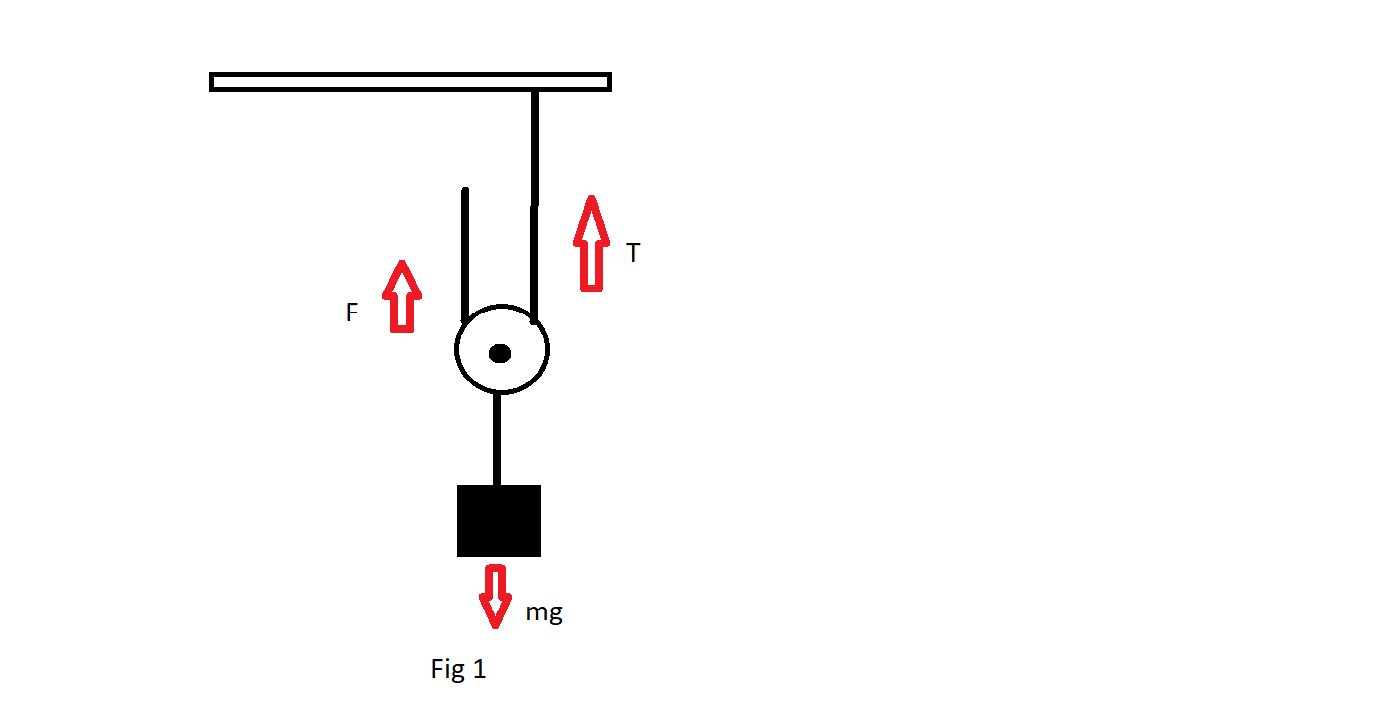
How do you calculate the effort force of the pulley?


Answer
484.8k+ views
Hint: Effort force is the force used to move an object over a distance. This force has to be overcome to do work on an object via a simple machine. We can calculate the effort force of the pulley by dividing the load by the number of ropes. From the diagram, F is the effort force.
Complete answer:
Pulley is the rusty iron wheel that has a rope around it. The wheel has a groove and in the groove, the rope will be fitted. Pulling on the rope the wheel rotates. Pulleys are usually used to lift heavy objects.
The object lifted by the pulley is called the load and the force required to lift the load is called effort force.
In the diagram, a block of wood is lifted upwards using the pulley using some force F which is called the effort force. The effort is usually calculated by dividing the load by the number of ropes.
In the diagram, there is only one rope. If we take the mass of the block to be \[20kg\]we have to divide the mass by the number of ropes. Since we have only one rope in the diagram.
Effort= \[\dfrac{{20kg}}{1}\]
Effort= \[20kg\]
The person lifting the block will experience a weight of \[20kg\].
Suppose if the same block is lifted by double rope pulley system then the effort will be,
Effort= \[\dfrac{{20kg}}{2}\]
Effort= \[10kg\]
The person lifting this block will experience the weight only \[10kg\].
Note:
There are three types of pulleys
1.Fixed Pulleys
2.Movable Pulleys
3.Compound Pulleys
Note in the above example the pulley system offers a mechanical advantage of 2. The mechanical advantage (MA) of a pulley system is equal to the number of ropes supporting the movable load. The real mechanical advantage of the pulley is in using many pulleys at once.
Complete answer:
Pulley is the rusty iron wheel that has a rope around it. The wheel has a groove and in the groove, the rope will be fitted. Pulling on the rope the wheel rotates. Pulleys are usually used to lift heavy objects.
The object lifted by the pulley is called the load and the force required to lift the load is called effort force.
In the diagram, a block of wood is lifted upwards using the pulley using some force F which is called the effort force. The effort is usually calculated by dividing the load by the number of ropes.
In the diagram, there is only one rope. If we take the mass of the block to be \[20kg\]we have to divide the mass by the number of ropes. Since we have only one rope in the diagram.
Effort= \[\dfrac{{20kg}}{1}\]
Effort= \[20kg\]
The person lifting the block will experience a weight of \[20kg\].
Suppose if the same block is lifted by double rope pulley system then the effort will be,
Effort= \[\dfrac{{20kg}}{2}\]
Effort= \[10kg\]
The person lifting this block will experience the weight only \[10kg\].
Note:
There are three types of pulleys
1.Fixed Pulleys
2.Movable Pulleys
3.Compound Pulleys
Note in the above example the pulley system offers a mechanical advantage of 2. The mechanical advantage (MA) of a pulley system is equal to the number of ropes supporting the movable load. The real mechanical advantage of the pulley is in using many pulleys at once.
Recently Updated Pages
Master Class 11 Economics: Engaging Questions & Answers for Success

Master Class 11 English: Engaging Questions & Answers for Success

Master Class 11 Social Science: Engaging Questions & Answers for Success

Master Class 11 Biology: Engaging Questions & Answers for Success

Class 11 Question and Answer - Your Ultimate Solutions Guide

Master Class 11 Business Studies: Engaging Questions & Answers for Success

Trending doubts
What is meant by exothermic and endothermic reactions class 11 chemistry CBSE

10 examples of friction in our daily life

One Metric ton is equal to kg A 10000 B 1000 C 100 class 11 physics CBSE

Difference Between Prokaryotic Cells and Eukaryotic Cells

What are Quantum numbers Explain the quantum number class 11 chemistry CBSE

1 Quintal is equal to a 110 kg b 10 kg c 100kg d 1000 class 11 physics CBSE




